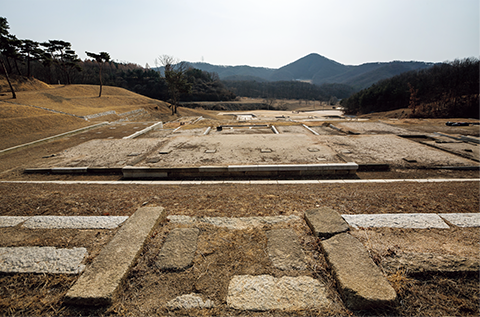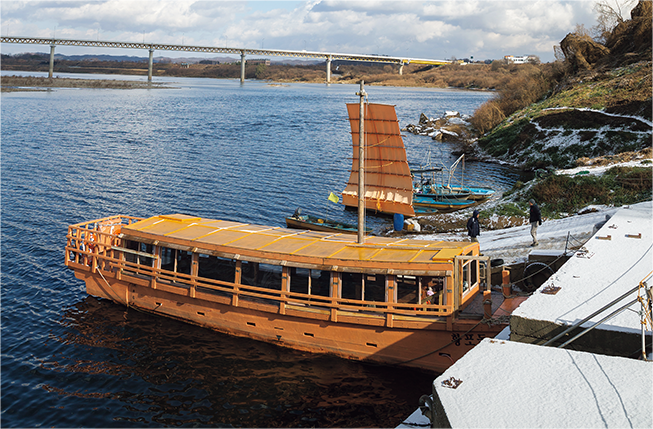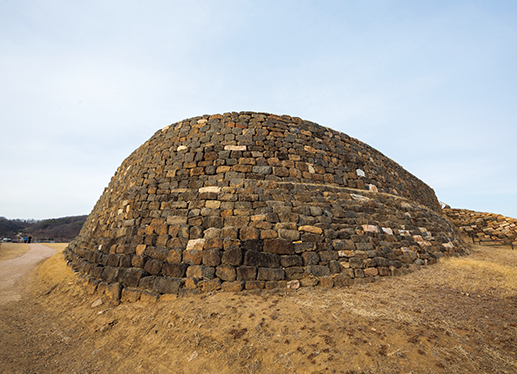“Do [the way] is the path from here to there.” This unembellished definition appears in the book “Self-Admonition from the Doctrine of the Mean” (Jungyong jajam), written by Jeong Yak-yong (1762-1836). If you are puzzled by the austerity of one of the greatest Confucian scholars and thinkers of the Joseon Dynasty, it means you are ready to consider the circumstances of his time. Take a step closer and you might hear his sighs of anxiety and distress.
Two rock-carved Buddhas, standing 17.4 meters high on a mountain slope in Yongmi-ri, Paju, look over a village below.These twin figures of Maitreya, designated Treasure No. 93, were d in the 11th century during the Goryeo Dynasty.Clearly visible from afar, in the days of yore they served as a landmark for travelers on the road along the Uijuro.
In the Confucian classics, do (dao in Chinese), or “the way,” is ambiguously explained as displays of the innate nature of human beings (“The Doctrine of the Mean”), or of illustrious virtue (“The Great Learning”). According to Zhu Xi (1130-1200), it is abiding by “the principles that must naturally be practiced.” It therefore seems that neo-Confucianism sought to explore the absolute and transcendental principles innate in all human beings and things.
Independence Gate (Dongnimmun), standing on a busy street in Seodaemun, Seoul, was erected in 1897 with public funds to express Koreans’ will to protect their nation from external powers. It is located on the original site of Yeongeunmun, the gate where Chinese envoys were received during the Joseon Dynasty. Considered a symbol of subservience to the powerful, the gate was torn down by reformists.
The Way and the Road
These principles became the founding tenets of the Joseon Dynasty (1392-1910). However, the Confucian scholars of Joseon failed to forestall power politics, and the state’s strict class system exacerbated social imbalances and inequality. Later, the Japanese and Manchu invasions dealt a further blow to the nation. Jeong Yak-yong, a versatile genius who lived from the 18th to the 19th century, reinterpreted the “do.” Diverging from its metaphysical definitions, he viewed “the way” as the process of managing life from birth to death, or the progression of social development. His aim was to open the eyes of the ruling elites in order for them to recognize the urgent need for reforms.
Jeong and like-minded proponents of reform subscribed to Silhak (“Practical Learning”), a school of thought and social reform movement that emerged in the latter half of the 17th century, applying its focus on practical matters. They cast aside Confucianism and its rigid framework of self-discipline to argue for land reform and stable livelihoods of farmers as the pillars of the nation. They also advocated commerce and distribution as new ways to earn a living. When these ideas were embraced by brilliant monarchs such as King Yeongjo (r. 1724-1776) and King Jeongjo (r. 1776-1800), change came to Joseon. The movement prompted diverse policy suggestions and publications. Among them was “Survey of Routes and Roads” (Dorogo), a lesser known revelation on anthropogeography, written by Shin Gyeong-jun (1712-1781) and published in 1770.
This road atlas described overland and maritime routes and even routes followed by royal processions. That’s not all. The book also included an ix on all official markets, called gaesi (“open market”), where frontier trade was conducted. In the preface, the author pointed out that the state is duty bound to systematic management of the road network. He cited the increase in the number and types of people using the roads, including commoners and merchants, accompanying the expansion and diversification of markets. The book’s preface notes: “The roads have no owners; only those who are on the roads are the owners.” Shin obviously believed that the roads were a practical means to achieve the autonomous and people-oriented ideals of Confucianism and indeed its ultimate ive. Preventing the pillage of resources and opening the channels for distribution was the true ive of “the road,” and consequently “the way.”
Following the Emissary Road

Underground remains of Hyeeumwon, a state-run inn of the Goryeo Dynasty for officials traveling through Hyeeum Hill in Gwangtan-myeon, Paju, a major bypass on the road from Kaesong to Hanyang [today’s Seoul]. The location of the inn was confirmed in 1999 when a roof tile inscribed with its name was discovered here.
In his book, Shin Gyeong-jun organized the nation’s road system into six main arteries, the first being Uijuro. Starting in Seoul, then named Hanyang, the road ran northward to Uiju along the banks of the Amnok (Yalu) River via Kaesong, Hwangju, Pyongyang, Anju, and Jeongju. Uijuro was considered the first road because it functioned as the official road leading from the capital to Pyongyang, the seat of the provincial government office of Pyongan, as well as the route for trade and exchange with China. Joseon’s relationship with China as a tributary state needing the Chinese emperor’s investiture of its king continued through five centuries until 1894. Uijuro was the only road used for this exchange.
During the Daehan Empire period (1897-1910), when the nation took its first difficult steps toward modernization, and under the ensuing Japanese occupation (1910-1945), Uijuro was replaced by new roads. Later, when the nation was divided into North and South in the wake of the Second World War, most of the cities Uijuro had passed through came under North Korean control. The distance between Hanyang and Uiju on the border between Korea and China was 1,080 li (424 km).
Today, the distance between Seoul and the closest point on the southern side of the DMZ that civilians can freely visit is 45 kilometers, or a 40,000 won taxi ride away. But, of course, the taxi would not use the old road. During the Joseon period, the lumbering speed of a diplomatic mission to China would translate into four days on the 45-kilometer route.
Hwaseok Pavilion, overlooking the Imjin River in Paju, was built in 1443 by Yi Myeong-sin, an ancestor of the great Confucian scholar Yi I. After he retired from government service, Yi I spent the rest of his life at his country home nearby, guiding his disciples.
Day One: Donuimun to Byeokjegwan
“After breakfast, when I reached Hongjewon with my father, tens of people from all classes came out to bid us farewell. We had feasted on the food and drink that the king had specially bestowed on us. When it grew dark, my father left and we headed for Goyang. We reached Goyang late at night and went to sleep.” - From “Yanjing Memoir” (Yeongi) by Hong Dae-yong
Uijuro started at Donuimun, the west gate of the city of Hanyang. No traces of the gate remain because it was torn down by the Japanese government-general in 1915. But its location is known to be on a hill along the way from Gyeonghui Palace to Dongnimmun (Independence Gate). “Farewell at Seogyo” (Seogyo jeonuido), a painting by Jeong Seon (1676-1759) dated 1731, depicts a Chinese mission traveling after a farewell banquet. The procession is seen passing Yeongeunmun, the gate in front of Mohwagwan, where Chinese envoys were received. It was located just outside the west gate of the city in an area known as Seogyo, meaning the “western outskirts.” After the Sino-Japanese War of 1895, U.S.-educated reformist leader Suh Jai-pil asserted that Korea must sever its ties with Qing China and adopt Western civilization. He led a fund-raising campaign and demolished Yeongeunmun, and in November 1897 erected Dongnimmun in its place as a symbol of Korea’s independence from China.
The feelings detected in “Yanjing Memoir,” the record of a trip to Qing China written by Hong Dae-yong (1731-1783), are pride and shame. At the time, China was enjoying the final days of the golden age of the Qianlong Emperor. Though more than a century had passed since its submission to the Qing, Joseon internally adhered to its position of “distinguishing between the civilized and the barbarians.” It considered the Manchus of Qing as falling into the latter category, which led to an anti-Qing policy snubbing the dynasty that had grown into an empire with global influence through openness. Hong Dae-yong and other scholars of the Northern Learning School (Bukhakpa) questioned this stance and longed for an opportunity to experience Qing for themselves to discover the real state of affairs. Hong was a spirited man. When he saw a pipe organ for the first time at the cathedral in Beijing, he immediately tried to reproduce the tune on his geomungo, the six-ed Korean zither. Throughout the trip, which spanned late 1765 to early 1766, he constantly asked himself the meaning of true shame and what he should be ashamed of.
To reach Hongjewon, the first of the travelers’ inns (called won) operated by the state along Uijuro, one had to cross Muakjae, an infamous mountain pass where tigers were known to prowl. Today, it is a gently sloping road but back then, it was barely wide enough to accommodate a single horse.
The lush pine forest and streamside setting made Hongjewon an ideal place to give a farewell banquet to a mission leaving for China. The official mission consisted of some 30 people, but with the addition of coachmen, servants and workers carrying the tribute gifts, small missions had some 300 people and larger ones over 500. In addition, scores of spectators, friends and relatives came to send off the mission. Today’s Inwang Market developed out of an alley where rice cakes were sold to the usual horde of well-wishers on departure days.
When the mood mellowed after feasting on food and liquor presented by the king, farewell gifts such as fans, ink brushes, candlesticks and rain hats were exchanged. The revelry had to end at an early hour in order to reach Byeokjegwan, the first overnight stop on the journey.
When I spend a night reading the records of diplomatic missions to China written by our ancestors,
I always dream about losing my way.
My carriage gets stuck in the mud, and not knowing which way to turn, I flounder throughout the night.
Day Two: Byeokjegwan to Paju County Office

At Duji Wharf, in the upper reaches of the Imjin River, replicas of ancient sailboats take tourists on a 6-kilometer ride to Gorangpo. This service began in March 2004, allowing civilians access to a part of the river that has been tightly restricted since the end of the Korean War in 1953.
“With two attendants, we passed through the Hyeeum Hill and reached Paju around noon. I sent a letter ahead to Master Seong Hon and waited for a reply, but he advised me against visiting him. I sent a messenger straight away with a letter of thanks and sought his teachings.” - From “Diary of a Journey to the Ming Court” (Jocheon ilgi) by Jo Heon
After departing from Byeokjegwan, the diplomatic mission traveled along what today is Local Route No. 78. At the bend of the road, the mission would have reached a steep mountain pass called Hyeeumryeong, leading from Goyang to Paju. It was a treacherous byway that served as a shortcut between Hanyang and Kaesong since the Goryeo Dynasty. Later, an inn called Hyeeumwon and a Buddhist temple offered a chance to rest. Some two kilometers from the site of Hyeeumwon in the direction of Paju, there are two huge standing Buddha figures carved into a cliff. As they passed these Buddhas, defenseless ordinary travelers might have huddled together in an attempt to ward off robbers.
Those departing on a trip probably prayed for a safe journey in front of the Buddha images, and those returning felt relieved when they came into view from afar. The gaze of these simple, rock-carved Buddhas now rests on a graveyard at the foot of an opposite mountain. To the left, the summits of Mt. Bukhan can be seen in the far distance, in the direction of Seoul.
Jo Heon (1544-1592) was a member of the Joseon mission to celebrate the birthday of the Wanli Emperor in 1574. On the way to China, it was not unusual for mission members to stop and pay respects at the graves of their ancestors or visit the homes of famous scholars to listen to their teachings. In Paju, the famous scholars Seong Hon (1535-1598) and Yi I (1536-1584) lived in the friendly confines of the Ox Gorge (Ugye) and the Chestnut Valley (Bamgol, or Yulgok). Jo Heon, born and raised in nearby Gimpo, was a disciple of these great scholars.
Later he succeeded the academic lineage of Yi I, and in royal court he was known for his candidness. In 1592, when the first Japanese invasion occurred, he led 700 “righteous soldiers” and died in battle.
Seong Hon’s grave and memorial hall are found just past the rock-carved Buddhas. Paju Elementary School now stands on the site of the old Paju county office, and a tunnel through the Hyeeum Hill was completed in 2016.
Day Three: Paju to Kaesong
“We left Paju early in the morning and when we reached Yulgok, I visited Yi Suk-heon (another name of Yi I). Suk-heon was ailing and had yet to recover. We waited a long time and he finally appeared but looked very tired. We sat down and lamented the state of affairs in the country and talked about various matters, such as the mind of man and the mind of the way, and the inseparability of rational principle (i) and material force (gi).” - From “Diary of an Envoy to China” (Jochongi) by Heo Bong
Heo Bong (1551-1588) was the elder brother of poetess Heo Nanseolheon (1563-1589) and Heo Gyun (1569-1618), author of the novel “The Story of Hong Gildong.” After greeting Yi Suk-heon, Heo Bong went up to Hwaseok Pavilion, where his friend often visited.
From there, he could see a new house being built by Suk-heon, which still had no dividing walls and sat on a steeply sloping site.
It was Suk-heon’s wish to gather his whole family together to live in Yulgok. As he looked down at the winding Imjin River and the mountains stretched out beyond, Heo Bong felt compassion for the dire circumstances of the great scholar who had left his post as royal secretary just three months earlier.
But the year after the occasion described above, when powerful Confucian scholars dissented over the direction of political reform, Heo Bong found himself confronting Yi I, the man he had so respected and looked up to with such compassion. In 1583, he ended up charging Yi I with neglecting his official duties. Removed from his post as minister of military affairs, Yi I’s illness deepened and eventually led to his death early the following year. All that he left behind were the books in his study and a few flints. As for Heo Bong, he did not survive unscathed either but was exiled. He never returned to court and wandered aimlessly until he died at the age of 38. Not far from Hwaseok Pavilion is Jaun Seowon, the Confucian academy where the spirit tablet of Yi I is enshrined, as well as a memorial hall dedicated to the scholar.

Horogoru is a triangular-shaped fort of the Goguryeo Kingdom built on basalt. The length of the remaining walls is some 400 meters. The section of the Imjin River nearby served as the border between Goguryeo and Silla for 200 years from the mid-sixth century. It was a battleground between the two ancient Korean states and later between Silla and Tang China.
The Imjin ferry crossing is hidden by a thicket to the left of Hwaseok Pavilion. From this point, Uijuro crosses the Imjin River to Dongpa because the river is narrow and shallow here. Naturally, the ferry crossing was a strategic defense position of the capital, and, in fact, was part of the official route used by government officials and envoys. Merchants and ordinary travelers had to go further north to Gorangpo to cross the river. Gorangpo is the northernmost port on the Imjin River, where fishery products from the west coast and crops from the inland were traded. It lies by a wide, shallow stretch of water, easily crossed on foot with rolled up pants. Invading Japanese soldiers crossed this point in the late 16th century, as did North Korean tanks in the Korean War. Nearby is an ancient fort from the Goguryeo Kingdom, named Horogoru, and the tomb of King Gyeongsun, the last monarch of Silla, indicating that it was a well-used route as early as the Three Kingdoms period (57 B.C. - A.D. 676).
Though now in a military area, old sailboats take visitors from Duji Wharf in the upper reaches of the Imjin River to the vicinity of Gorangpo, and at the Imjin ferry crossing, exploration trails are occasionally opened for ecological study. From here, Kaesong in North Korea is just some 40 li (15 km) away - across the DMZ.
Gorangpo, the northernmost port on the Imjin River, is where fishery products from the west coast and crops from the inland were traded. Upstream there is a wide, shallow stretch of water that can be easily crossed on foot, which made the location strategically important to armies in the past.
Day Four: Still in a Dream
When I spend a night reading the records of diplomatic missions to China written by our ancestors, I always dream about losing my way. My carriage gets stuck in the mud, and not knowing which way to turn, I flounder throughout the night. For solace, I write down a line that I came across at dawn after one such night.
“No society is perfect. It is in the nature of all societies to include a degree of impurity incompatible with the norms they proclaim and which finds concretein a certain dosage of injustice, insensitivity and cruelty.” - From “Tristes Tropiques” (Sad Tropics) by Claude Lévi-Strauss
Lee Chang-guyPoet and Literary Critic
Ahn Hong-beomPhotographer